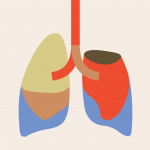Looking at the AACR's Annual Cancer Progress Report
- As of January, there were more than 18 million cancer survivors in the U.S., and the age adjusted overall cancer death rate has declined by 32 percent between 1991 and 2019 in the United States, according to the recently released American Association for Cancer Research (AACR) Cancer Progress Report.
- Advancements in cancer research are promising, but one of our experts says “we may see some not great numbers in the coming years because of the effect of COVID-19 on access/screening during the pandemic.”
- The report outlines other promising statistics, but it also outlines negative ones. For example, the incidence of certain cancers such kidney, pancreatic and uterine cancer is rising. And “minority patients have seen significantly less improvement and have worse survival than their white peers,” according to one of our experts.
The AACR’s annual report provides statistics for incidence, mortality and survivorship rates, talks about the latest research and discusses ongoing challenges in cancer care.
Read More- As of January, there were more than 18 million cancer survivors in the U.S.
- In the past three years, the number of adults and children living in the United States with a history of cancer rose by more than a million.
- Researchers predict that there will be 26 million survivors in the U.S. by 2040.
- The age adjusted overall cancer death rate has declined by 32 percent between 1991 and 2019 in the United States, a reduction that translates into nearly 3.5 million cancer deaths avoided.
- Among children and adolescents with cancer, overall death rates have declined by more than half between 1970 and 2019, largely due to advances in treatment.
- Advances have led to the increase in five-year relative survival rate for all cancers combined from 49 percent in the mid-1970s to nearly 70 percent from 2011 to 2017.
- Overall U.S. cancer incidence has been declining during the past two decades, albeit the rates have stabilized more recently.
- However, the incidence of certain cancers, such kidney, pancreatic and uterine cancer, is rising. For example, between 2000 and 2018, pancreatic cancer incidence increased significantly, with the greatest increase observed among women ages 15 to 34 years.
What Are Experts Saying?
To get a better understanding of what these statistics mean, SurvivorNet spoke with two of our experts to get their take on the progress report. Dr. Heather Yeo, a SurvivorNet medical advisor and colorectal surgeon/surgical oncologist at Weill Cornell Medicine and New York-Presbyterian, says the news is “exciting” overall. “It is good to see that cancer mortality is improving, much of this is due to prevention and screening,” she told SurvivorNet. “We know downstream effects of preventative measures can take decades, so seeing these changes over time is encouraging.”More specifically, Dr. Yeo was pleased with the cigarette smoking and colon cancer screening statistics because she knows what a huge impact these things can have on cancer incidence and detection.
“I was really excited to see that cigarette smoking among U.S. adults has decreased from 42% ins 1963 to 12.5% in 2020. As over 60% of lung cancer deaths can be attributed to smoking,” she said. “As a colorectal surgeon, I was excited to see colon cancer screening nationally improve, although there is still room for improvement.
“Colon cancer screening is a tool that has consistently shown it decreases cancer incidence and improves early detection and cure as well. We know that physical activity improves cancer survival and also can be preventative long term.”
Another important area of progress highlighted in this report has to do with promising treatment advances.
"The tangible progress being made against cancer is also underscored by the new precision medicine-based therapeutics that were approved during the 12 months covered by this report,” the report reads. “Many of the newly approved therapeutics have expanded the number of treatment options for patients with cancer, while some have provided the first ever therapeutic option for certain diseases, including some difficult-to-study rare forms of cancer.”
Dr. Yeo made sure to note that recent cancer research has been promising.
“One of the most exciting things about what is going on in cancer care is cancer research,” she wrote. “Understanding the biologic, genetic, immune and molecular mechanisms of cancer is helping us to target cancers in a more specific way.”
During the 12 months covered by the report (August 1, 2021 to July 31, 2022), progress in cancer research included the following advancements:
- The U.S. Food and Drug Administration (FDA) approved eight new anticancer therapeutics, including the first drug to treat uveal melanoma, the most common form of eye cancer in adults; the first molecularly targeted therapeutic for treatment of cancer patients with Von Hippel-Lindau syndrome, a rare inherited genetic disorder; and the first new immune checkpoint inhibitor against a novel target in eight years.
- The FDA expanded the use of 10 anticancer therapeutics and approved two new diagnostic imaging agents.
- There has been intense research and exciting progress in the use of AI in the clinic, leading to numerous FDA approvals for AI-based tools that can help clinicians detect cancers earlier in their evolution and provide more complete diagnoses, with potentially curative outcomes.
What Do Checkpoint Inhibitors Do For Cancer?
One specific area of cancer treatment where we’ve been seeing extraordinary progress is immunotherapy. In 2011, there was only one checkpoint inhibitor approved by the FDA, according to the report. But as of July 31, 2022, there were nine checkpoint inhibitors approved by the FDA.
Checkpoint inhibitors are a class of immunotherapy drugs that specifically target proteins found either on immune or cancer cells to prevent their binding together. In other words, these drugs don’t kill cancer cells directly, but instead stimulate the immune system to attack cancer cells while hopefully not affecting other surrounding healthy cells.
"Each doctor or clinician tends to have his or her favorite advances depending… on the field. If I had to choose broadly in oncology, I think there are three or four themes. One is the increasing role of immune checkpoint inhibitors," Dr. Wui-Jin Koh, the senior vice president and chief medical officer at the National Comprehensive Cancer Network, told SurvivorNet in a previous interview.
Immune checkpoint inhibitors are approved to treat some people with a variety of cancer types, including:
- breast cancer
- bladder cancer
- cervical cancer
- colon cancer
- head and neck cancer
- Hodgkin lymphoma
- liver cancer
- lung cancer
- renal cell cancer (a type of kidney cancer)
- skin cancer, including melanoma
- stomach cancer
- rectal cancer
- any solid tumor that is not able to repair errors in its DNA that occur when the DNA is copied
"I think that the most powerful combinations coming up are based on combining immune blockers or enhancers but also drugs that can directly kill tumor cells to really have a double whammy,” Dr. Jim Allison, the chair of the department of immunology at MD Anderson Cancer Center and the winner of the 2018 Nobel Prize for Physiology or Medicine, previously told SurvivorNet. “And they can be used perhaps even more safely than what we're doing now and get better responses."
And while immunotherapies and other treatment advances are certainly promising news. There is data coming from the AACR progress report that is not good.
“While it is encouraging that many cancer types have had decreased incidence, the increase in certain cancers kindey, pancreas and uterine cancers is concerning,” she wrote. “Particularly in young women. Attention needs to be paid to environmental factors.”
As a gynecologic oncologist for NYU Langone's Perlmutter Cancer Center, Dr. Whitfield Growdon took particular note of the increase in endometrial cancer incidence.
“The recent AACR progress report has highlighted the notable increase in endometrial cancer incidence and this data should serve as a call to arms for cancer researchers and providers to improve awareness and therapeutic interventions for this cancer,” he wrote in a statement for SurvivorNet. “Specifically, it has been noted that mortality has been steadily increasing, particularly in under represented minority racial groups.
“While some of this shift can be attributed to increasing obesity rates in an ever aging general population, researchers have noted an increased rate of aggressive uterine cancers with alternate drivers of cancer development. Awareness projects and innovative clinical trials that seek to educate and enroll women of all racial backgrounds are urgently needed to understand which groups of women with endometrial cancers will respond to novel therapeutics. In addition to these efforts, dedicated research funding to better understand molecular endometrial cancer variants is in dire need.”
Dr. Yeo also pointed out the glaring disparities in cancer care illustrated in the progress report by noting that “minority patients have seen significantly less improvement and have worse survival than their white peers.”
How to Address Racial Disparities in Cancer Care
Some examples of the disparate cancer incidence, treatment and outcomes provided by the report included the following data:
- The incidence of gastric cancer is nearly twice as high in American Indian/Alaska Native, Asian, Black and Hispanic individuals compared to non-Hispanic White individuals.
- Native Hawaiian or Other Pacific Islander patients are 38 percent more likely to present with advanced-stage head and neck cancer and 18 percent more likely to die from the disease compared to non-Hispanic White patients.
- Gay men (12 percent) are more likely than heterosexual men (8 percent) to report lifetime diagnoses of cancer.
- The development of breast cancer-related lymphedema, which occurs after damage to the lymphatic system during surgery, occurs 3.85 times more often in Black women and 1.47 times more often in Hispanic women. (Lymphedemas are often painful and require the use of special equipment to manage symptoms.)
- American Indian or Alaska Native patients with kidney cancer were 49 percent more likely than White patients to undergo complete surgical removal of the kidney, a procedure associated with higher mortality rates.
- Native Hawaiian or Other Pacific Islander women with early-stage breast cancer were more likely than White women to experience a delay of 10 days following cancer surgery to receive radiation.
- Black women with breast cancer living in rural South Carolina were two times more likely than White women to experience delays in recommended chemotherapy.
- Black patients with lung cancer were more likely than White patients to experience a delay of 28 days to receive a prescription for one of the FDA-approved molecularly targeted therapeutics.
- Hispanic patients with metastatic liver cancer were 37 percent less likely than White patients to receive immunotherapy.
- Black and Hispanic patients with cancer experience adverse financial events twice as often as White patients, leading to increased use of financial coping behaviors, such as skipping medications.
In regards to the disparities in improvement and survival for minority patients compared to their white peers, Dr. Yeo suggested a few reasons.
“Much of this has to do with sociodemographic issues, but there are also clear disparities in the care and access to care,” Dr. Yeo told SurvivorNet. “We know some of this stems from a lack of diversity in the physician workforce as minority patients often feel more comfortable and get better care from a diverse workforce.
“There are also likely dietary and environmental contributors at play.”
While we can celebrate promising statistics and direct our efforts to issues that need addressing, it’s also important to consider what the future will look like. Dr. Yeo remains hopeful but cautions that the effects of COVID-19 will have a negative impact on statistics in the coming years.
“I do think we may see some not great numbers in the coming years because of the effect of COVID-19 on access/screening during the pandemic,” she told SurvivorNet. “But overall the key message here is that cancer research and care is making improvements.”
Learn more about SurvivorNet's rigorous medical review process.






